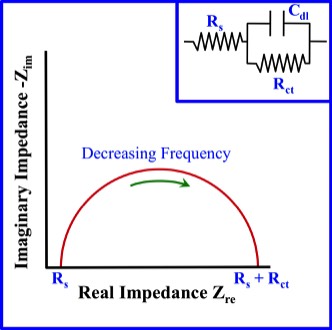Currently viewing
Menu
Electrochemical Impedance Spectroscopy (EIS)
EIS is an Alternating Current (AC) Test. One of the main advantages of this technique is the ability to assess the degradation of polymer-coated metals (e.g. painted metals). Assessing polymer-coated systems is something which cannot really be performed successfully using Direct Current (DC) techniques.
Impedance (Z) in an Alternating Current (AC) circuit behaves similarly to Resistance (R) in a Direct Current (DC) circuit. There are a number of instrument arrangements that can be used for EIS. One common instrument combination uses a Potentiostat connected to a Frequency Response Analyzer (FRA). Many researchers use this instrument combination, but it is not the only one possible.
During a test, some potential (often Ecorr) is maintained by the potentiostat. At the same time, the FRA is employed to superimpose a small fluctuating potential and characterize the sample's response to this voltage stimulus.
Impedance (Z) in an Alternating Current (AC) circuit behaves similarly to Resistance (R) in a Direct Current (DC) circuit. There are a number of instrument arrangements that can be used for EIS. One common instrument combination uses a Potentiostat connected to a Frequency Response Analyzer (FRA). Many researchers use this instrument combination, but it is not the only one possible.
During a test, some potential (often Ecorr) is maintained by the potentiostat. At the same time, the FRA is employed to superimpose a small fluctuating potential and characterize the sample's response to this voltage stimulus.

The Curve shown above represents the type of experimental data that would be generated for a bare metal experiencing Activation Polarization. In this case, the Solution Resistance (Rs) is found using the high frequency data, and the value for the Charge Transfer Resistance (Rct) is defined by the low frequency data. In the simplest case, the value for Rct is the same as for the Polarization Resistance (Rp). Once Rp is defined, it becomes possible to find the corrosion rate.
The situation is more complex for polymer-coated metallic substrates. Nevertheless, for the first time we were able to experimentally demonstrate that the mass loss measured in situ for a polymer-coated metallic substrate correlates with the mass loss defined during an EIS test when the Rct can be defined unambiguously from EIS data. For additional information, please read the following two Papers:
The situation is more complex for polymer-coated metallic substrates. Nevertheless, for the first time we were able to experimentally demonstrate that the mass loss measured in situ for a polymer-coated metallic substrate correlates with the mass loss defined during an EIS test when the Rct can be defined unambiguously from EIS data. For additional information, please read the following two Papers:
"In Situ Underfilm Corrosion Rate Measurement by Magnetic and Electrochemical Techniques", Electrochemical and Solid-State Letters, Vol. 3, p. 275 (2000).
"The Correlation Between Substrate Mass Loss and Electrochemical Impedance Spectroscopy Data for a Polymer-Coated Metal", J. Electrochem. Soc., Vol. 149, p. B265 (2002).
"The Correlation Between Substrate Mass Loss and Electrochemical Impedance Spectroscopy Data for a Polymer-Coated Metal", J. Electrochem. Soc., Vol. 149, p. B265 (2002).
Currently viewing
Page last updated: 3/4/25
